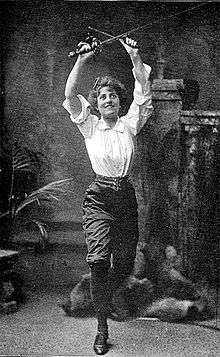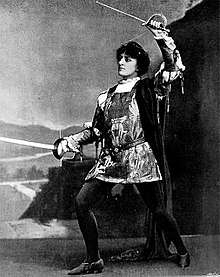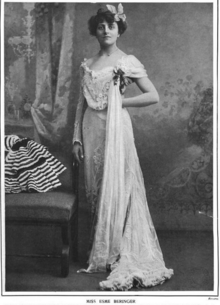Esme Beringer
Esme Beringer (5 September 1875 – 31 March 1972) was an English actress who was noted for her fencing skills.



Early life
Esme Beringer was born in London, the daughter of Oscar Beringer and Aimée Daniell Beringer.[1] Her father was a composer; her mother was a novelist and playwright. Her younger sister Vera Beringer was best known as a child actress.[2] Her brother Guy Beringer was a journalist; he is credited with coining the word "brunch" in 1895.[3]
Career
Esme Beringer first appeared on stage in 1888, as a boy character, Dick Tipton, in Little Lord Fauntleroy (she also substituted for the title character, usually played by her sister). By 1893 she was very active on the London stage. Beringer's athletic physique and extensive training with swords made her well-suited to breeches roles,[4] as when she played Romeo in 1896[5] (opposite her sister Vera as Juliet).[6][7] Other stage appearances by Beringer included The Prince and the Pauper (1890), Foreign Policy (1893, by Arthur Conan Doyle), Bud and Blossom (1893, by Gertrude Elizabeth Blood), Three Wayfarers (1893, by Thomas Hardy), Bess (1893), Hypatia (1893), The Gentleman Whip, The New Boy, Loyal, Hal the Highwayman, The Lady's Idol, The Strange Adventures of Miss Brown, The Benefit of the Doubt, The Late Mr. Castello, Gossip (1896), A Mother of Three, Woman's World, The Pilgrim's Progress, The Last of his Race, The Winter's Tale,[8] Saviolo (1902, by Egerton Castle), The Trifler (1905), The Anarchist (1908),[9] The Blue Stockings (1913),[10] and Lucky Jim (1916).[11][12][13] She also performed on vaudeville, in The Point of the Sword.[1]
Beringer studied historical swordplay with Alfred Hutton as well as his colleague Egerton Castle and was likely a member of the Bartitsu Club.[14] She participated in a number of historical fencing lectures and displays during the 1890s and early 1900s and also taught classes for the "Actresses' Foil Club" during World War I.[15] After the war, she starred in more Shakespearean roles, including "Constance" in King John (1925) opposite Henry Baynton.[16]
Esme Beringer's film appearances included All the World's a Stage (1917), The October Man (1947), Something in the City (1950), and Castle in the Air (1952). She also made some early television appearances, in Craven House (1950), and The Monster of Killoon (1952, by Geoffrey Kerr).
Personal life
Esme Beringer died in 1972, aged 96 years.
References
- Johnson Briscoe, "September 5: Esme Beringer" The Actor's Birthday Book (Moffat, Yard 1907): 200.
- "Vera Beringer" The Era Annual (1897): 29.
- Jesse Rhodes, "The Birth of Brunch: Where Did This Meal Come from Anyway?" Smithsonian Magazine (May 6, 2011).
- "Dramatic Notes" Womanhood (October 1901): 433.
- "A Lady Romeo" The Irish Playgoer and Amusement Record (December 14, 1899): 18.
- "The Beringers as Romeo and Juliet" The Sketch (May 13, 1896): 104.
- "Romeo Beringer's Fresh Duel" The Sketch (September 18, 1901): 345.
- Dennis Bartholomeusz, "The Winter's Tale" in Performance in England and America, 1611-1976 (Cambridge University Press 1982): 156. ISBN 9780521245296
- E. F. S., "The Stage from the Stalls" The Sketch (July 15, 1908): 12.
- Untitled news item, The Observer (November 30, 1913): 11. via Newspapers.com

- "Lucky Jim" The Observer (October 22, 1916): 7. via Newspapers.com

- "Esme Beringer" The Era Annual (1897): 29-30.
- "Portraits: Miss Esmé Beringer" Theatre (May 1, 1896): 282-283.
- "The Swordswoman: Esme Beringer" Archived 2018-01-06 at the Wayback Machine The Bartitsu Society (February 28, 2013).
- Tony Wolf, Ancient Swordplay: The Revival of Elizabethan Fencing in Victorian London (Freelance Academy Press 2013). ISBN 9780982591185
- Advertisement, The Manchester Guardian (September 23, 1925): 1. via Newspapers.com

External links
- Esme Beringer on IMDb
- Esme Beringer's filmography at BFI.
- Three photographs of Esme Beringer are in the collection of the National Portrait Gallery (London).
- A cigarette card featuring Esme Beringer, from the New York Public Library Digital Collections.